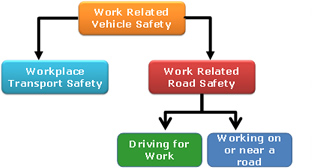Work Related Vehicle Safety (WRVS)
[How to protect workers from vehicle risks at work]

Work Related Vehicle Safety (WRVS) is the management of the hazards and risks associated with work activities involving vehicles and mobile equipment. This includes the risks to employers, self-employed people, employees and members of the public. WRVS encompasses both workplace transport safety and work related road safety.
Workplace Transport Safety(WTS) is the management of hazards and risks associated with any vehicle or piece of mobile equipment that is used by an employer, employee, self-employed person or a visitor in a fixed or temporary workplace but excludes work related road safety.
Work Related Road Safety (WRRS) is the management of the hazards and risks to persons engaged in or affected by work related driving or work activities on or near a road.
Driving for Work(DFW) is the activity of driving on the road for work purposes. This includes the risk posed to workers themselves and those not at work who may be affected by the work activity, such as pedestrians and other road users. Driving for Work excludes commuting to work, except where the person's journey either starts from their home and they are travelling to a work location that is not their normal place of work or their journey involves travel in a company provided vehicle.
Working on or near a road (WNR) is work activity carried out on or near a road and includes, for example, the safety of those working to maintain roads and street furniture, traffic wardens, engineers, emergency service personnel, road users and members of the public affected by the work activity.
View the Authority's Work Related Vehicle Safety Five Year Plan aimed at influencing a reduction in the number of people who are killed, seriously injured or who suffer illness as a result of vehicles being used for work in the workplace or on the road.
The Authority aims to help you better understand 'how to' protect workers from vehicle risks at work.